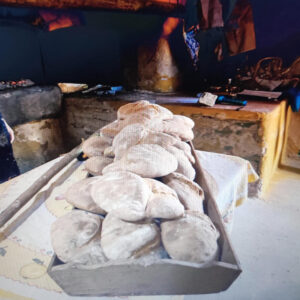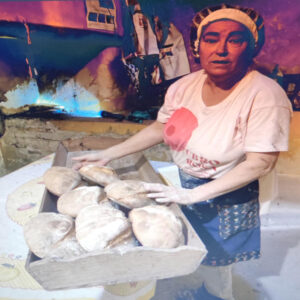The days of smoke in the chimney, The smell of hot bread cooked over a wood fire is back in the center of Beja, by the hands of two brothers, José and Lurdes Silva.
In Beja Historic Center, one of the streets leading into the Largo do Lidador, in honor of the heroic warrior Gonçalo Mendes da Maia, where they stand the Castle and the Cathedral, what was the last community oven in the city is located. People kneaded bread in the house and then the Ti Bia Gadelha boiled, charging a tithe in genres.
 In December 2017, more than three decades after the ruin and abandonment, the old oven was recovered and reopened by the Beja Heritage Defense Association (AdpBeja). The days of smoke in the chimney were back, the smell of warm bread cooked over a wood fire and the aroma of roasting lamb heads and legs.
In December 2017, more than three decades after the ruin and abandonment, the old oven was recovered and reopened by the Beja Heritage Defense Association (AdpBeja). The days of smoke in the chimney were back, the smell of warm bread cooked over a wood fire and the aroma of roasting lamb heads and legs.
Despite Florival Baioa's tenacity, president of AdpBeja, the initial “fever” of reopening the kiln faded away and little by little the crackling flames disappeared from inside the brick vault of the space.
About seven months ago, brothers José and Lurdes Silva, em residents Saved, county Beja, set out to give new life to the oven and after learning for almost two years the technique of making and baking bread, relived the stories of Ti Bia Gadelha.
José, 57 year old, He has a degree in Tourism and is a senior technician at the Municipality of Moura, and Lourdes, 60 year old, is domestic, and from his ingenuity and from their hands, the idea of ​​signing a protocol with AdpBeja was born.
 Rocins Vale, a hill eleven kilometers from Salvada, known as the “sacred place of bread and bakers” was where Lourdes, with Dona Lisete, “I learned to get my hands dirty and treat the flour with the care that good Alentejo bread deserves”, recalls happy.
Rocins Vale, a hill eleven kilometers from Salvada, known as the “sacred place of bread and bakers” was where Lourdes, with Dona Lisete, “I learned to get my hands dirty and treat the flour with the care that good Alentejo bread deserves”, recalls happy.
The brother, affectionately treated by “Pererucho”, tell Lidador NotĂcias (LN) the essence of the idea: “in addition to boosting the oven, promote heritage and create another tourist offer in the city. We must never forget the maxim that Alentejo is the breadbasket of the Nation”, justifies JosĂ© Silva.
The first batches of bread took place last May, during the “Beja Romana”, and in a protocol with the Municipality of Beja, the oven received hundreds of visitors who passed through the space to “see how bread is made, but, also take a bit of the Alentejo soul home”, remember “Pererucho”.
 “Continuing to recover heritage and not recovering the know-how is worthless. We promote themed events to promote heritage and turn baking bread into a life lesson”, justifies José Silva.
“Continuing to recover heritage and not recovering the know-how is worthless. We promote themed events to promote heritage and turn baking bread into a life lesson”, justifies José Silva.
Once a month, Ti Bia Gadelha's oven comes to life. “We do 50 bread and sell 3 euros each, just more 50 cents than an industrial loaf of bread. The idea is not to make money, but to make each person’s life better”, says the baker Lourdes.
The last cooking was last day 21 December and the next day 25 January, the smell of hot bread invades the surroundings of the Castle and the Cathedral.
The bread process in the Ti Bia Gadelha oven, told by José Silva
 In a clay bowl, It all starts with kneading unleavened flour, the one that adds the water and yeast from the “mother dough”, saved from previous kneading. Mixing done, This one is crushed with a punch and rolled up in a bowl. After an hour of fermenting, the dough is stretched and “cut” to shape the bread, with or without head. Fifteen to twenty minutes of “rest” and the bread is put in the oven to bake. Along the way, there is the difficult task of cleaning the inside of the oven., light the wood and remove the ash so that the bread does not have impurities.
In a clay bowl, It all starts with kneading unleavened flour, the one that adds the water and yeast from the “mother dough”, saved from previous kneading. Mixing done, This one is crushed with a punch and rolled up in a bowl. After an hour of fermenting, the dough is stretched and “cut” to shape the bread, with or without head. Fifteen to twenty minutes of “rest” and the bread is put in the oven to bake. Along the way, there is the difficult task of cleaning the inside of the oven., light the wood and remove the ash so that the bread does not have impurities.
Teixeira Correia
(journalist)
























